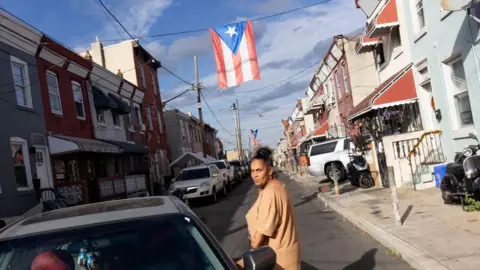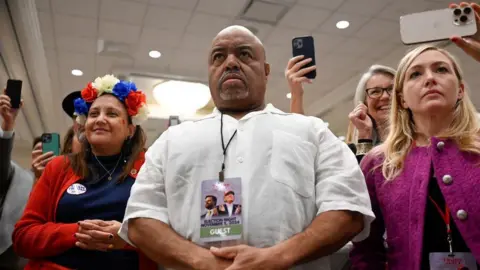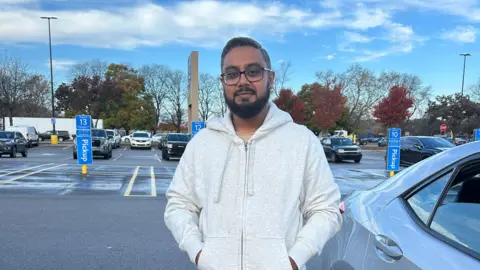'Easy, really' – why Latinos are flocking to Trump

 AFP
AFPDonald Trump has cruised to a crucial election victory over Kamala Harris, who has been nominated by some of the Democrats' most trusted voters.
The Republican president-elect has shown strength with the white working-class voters who first propelled him to the White House in 2016, while garnering significant support from Latino voters and posting better-than-expected performance among young Americans, especially men.
Among Latinos, who have been a key part of the Democratic voter base for decades, Trump benefited from a huge 14 percent increase compared to the 2020 election, according to polls.
Nowhere is Trump reshaping the electorate more clearly than in the states of Pennsylvania, Michigan and Wisconsin, the coveted “blue wall” that helped Joe Biden win in 2020.
This time, Trump won all three states, ending the hopes of Democrats that Harris could find a way to victory despite the pre-election night losses in the southern states of North Carolina and Georgia.
In his victory speech in Florida, Trump – who is poised to win the popular vote again – put the result in the “biggest, broadest, most united coalition” in American history.
“They were coming from all over. Union, non-union, African American, Hispanic American,” he told the roaring crowd. “We had everyone, and it was great.”
In Pennsylvania, a popular battleground state, Trump benefited from strong support from a growing Latino population.
 Getty Images
Getty ImagesExit polls suggested that Latinos in Pennsylvania made up about 5% of the total vote. Trump received 42% of that vote, compared to 27% when he ran against Joe Biden in 2020.
The votes will continue to change as votes are counted, but they are broadly representative of election trends.
In the state's “Latino belt” — the eastern industrial area that has swung to the right in the past two elections — some voters said they were not surprised by the result.
“It's easy, really. We liked the way things were four years ago,” said Samuel Negron, a Pennsylvania state police officer and member of the large Puerto Rican community in the city of Allentown.
Mr. Negron, and other Trump supporters in the now-majority Latino city, cited other reasons why their community is turning against Trump, including social issues and the perception that their family values are now more aligned with the Republican Party.
The most common factor, however, was the economy – specifically, inflation.
“Out here, you pay $5 for a dozen eggs. It used to be $1, or 99 cents,” Mr. Negron added. “Most of us have woken up, in my opinion, to the lies of the Democratic Alliance that things were better. We saw that things were better then.”
 Reuters
ReutersBefore the election, polls also suggested that many Latinos – across the US and in Pennsylvania in particular – were drawn to Trump's proposals to block immigrants from the US-Mexico border and pass tougher immigration laws.
Daniel Campo, a Venezuelan-American, said that Trump's accusations of creeping “socialism” reminded him of the situation he left behind in his country.
“I can hear you [migrants] they are leaving. But you have to do it the right way. I came by the way,” he said. “Things must be done legally. Many of us were concerned that the borders were already open” under the Biden-Harris administration, he said.
Overall, the Latino shift toward Trump, his hold on white working-class voters and his increased support among college-educated voters often form an insurmountable obstacle for Harris' campaign.
But Trump has also improved his position in some surprising areas.
In 2020 Joe Biden had a 24 point advantage with voters under the age of 30. This time, that lead was down to just 11 points. While black voters nationally still overwhelmingly support Harris (85%), in Wisconsin Trump's support among those people has doubled, from 8% in 2020 to 22% this election.
Some of the most important battlegrounds in Wisconsin were the three counties surrounding Milwaukee known as Wow counties – Waukesha, Ozaukee and Washington. Harris failed to make much of an improvement on Biden's 2020 vote share in these urban areas, while slipping in rural, white parts of the country dominated by Trump.
Early results also show that Harris failed to get as many votes as Biden in Wisconsin's largest, most diverse city – Milwaukee.
Michael Wagner, a professor at the University of Wisconsin-Madison, said his direct appeals to working-class voters may not have made much of a difference given the national political climate.
Ted Dietzler cast his vote at a fire station on the outskirts of the small town of Waukesha.
“I'm voting for Trump because of the border, the economy, and no more wars,” he said, wearing a Green Bay Packers hat.
“We saw a big difference when Trump was president,” Dietzler said, adding that he was drawn to Trump's embrace of former Democrats such as Robert F Kennedy Jr and Tulsi Gabbard, both of whom are seen as influential in the Trump administration.
“Inflation is a big thing, and I don't think Harris gets it,” he said. “I think we'll all be better off if Trump comes back.”

Trump's national economic messages hit home with working-class voters in the Midwestern state of Michigan, too.
With nearly all votes counted, Trump leads the state he lost in 2020 by about 85,000 votes. He increased his share of the vote in rural areas and in Macomb County, home to many working-class voters in the Detroit suburbs.
One of them, Nahim Uddin, who is a driver and used to work with Ford cars, voted for Trump because he said that the former president would lower prices.
“I went to buy a car – the interest rate had gone up,” said the 34-year-old. “That's why I voted for him.”
The same thing happened to Yian Yian Shein, a small business owner in the city of Warren, who said that Trump will lower the income tax and help people like him.
Democrats tried to adjust their economic messaging in Michigan, touting their investment in electric vehicle manufacturing while getting the endorsement of United Automobile Workers president Shawn Fain, a frequent Trump critic.
But Republicans have been able to “unfilter” those messages by arguing that the shift to electric vehicles will come at a cost to jobs, said Michigan State University professor Matt Grossmann.
Ultimately what united Democrats among white voters of all demographic groups was the perception that they were to blame for high prices and cut budgets.
“Overwhelmingly, voters have felt the economic pain of the post-Covid inflationary period, and they're taking it out on Biden” and Harris, said University of Michigan professor Jonathan Hanson.
Source link




